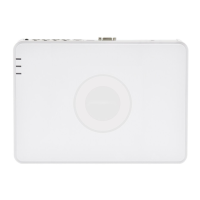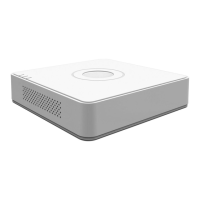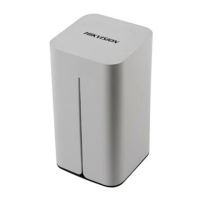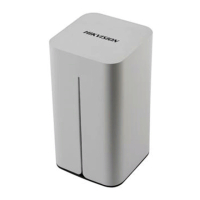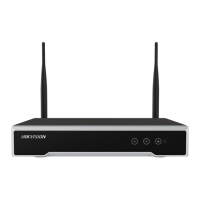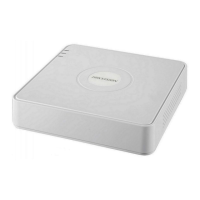
Do you have a question about the HIKVISION DS-7104NI-Q1 and is the answer not in the manual?
| Certification | FCC 15 B, ANSI C63.4-2014 CE EN50130-4, EN 61000-3-2, EN 61000-3-3 |
|---|---|
| Product color | Black |
| Output current | 1 A |
| Output voltage | 48 V |
| Power consumption (typical) | 10 W |
| Total Power over Ethernet (PoE) budget | 36 W |
| Operating temperature (T-T) | -10 - 55 °C |
| Operating relative humidity (H-H) | 10 - 90 % |
| HDD capacity | 0 GB |
| HDD interface | SATA, SATA II, SATA III |
| Maximum storage capacity | 6 TB |
| Number of HDDs installed | 0 |
| Number of HDDs supported | 1 |
| Networking standards | IEEE 802.3af, IEEE 802.3at |
| USB 2.0 ports quantity | 2 |
| Ethernet LAN data rates | 10, 100 Mbit/s |
| Power over Ethernet (PoE) | Yes |
| Ethernet LAN (RJ-45) ports | 5 |
| Supported network protocols | TCP/IP, DHCP, Hik-Connect, DNS, DDNS, NTP, SADP, SMTP, UPnP |
| Power over Ethernet (PoE) ports quantity | 4 |
| Video codecs | H.265+/H.265/ H.264+/H.264 |
| Input bandwidth | 40 Mbit/s |
| Output bandwidth | 60 Mbit/s |
| Maximum resolution | 1920 x 1080 pixels |
| Video input channels | 4 channels |
| Supported resolutions | 1920 × 1080, 1600 × 1200, 1280 × 1024, 1280 × 720, 1024 × 768 |
| Wi-Fi | No |
| Depth | 225 mm |
|---|---|
| Width | 265 mm |
| Height | 48 mm |
| Weight | 1000 g |
Instructions for using and managing the product, subject to change without notice.
Lists trademarks and their owners, specifically HDMI.
Product disclaimer regarding warranty, liability, and usage terms.
Details FCC compliance requirements and potential radio frequency interference.
CE marking and compliance with EU directives (EMC, RoHS, WEEE, Battery).
Indicates hazardous situations leading to death or serious injury.
Indicates hazardous situations leading to equipment damage or data loss.
Steps to activate the device by setting an admin password.
Instructions for logging into the device using pattern or password.
How to set a graphical unlock pattern for device login.
How to log in using the previously set unlock pattern.
Overview of the live view graphical user interface and shortcut menu.
Functions for controlling Pan, Tilt, and Zoom cameras.
How to set PTZ camera parameters before control.
Description of the PTZ control panel interface elements.
Overview of the playback interface and timeline.
How to play back normal recorded videos.
How to play back videos containing specific events.
Basic system settings like date, time, resolution, and user management.
Configure output resolution, system time, and other general settings.
Managing user accounts and permissions.
Configuring exception event hints and linkage actions.
Basic network settings like IP address, subnet mask, and gateway.
Configuring remote access via the Guarding Vision mobile application.
Setting up email notifications for events.
Adding and managing network cameras connected to the NVR.
Manually adding network cameras with specified parameters.
Adding IP cameras with custom parameters like IP address and protocol.
Configuring On-Screen Display settings for cameras.
Setting up motion detection areas and sensitivity.
Configuring virtual line crossing detection rules and directions.
Initializing and adding storage devices like HDDs and network disks.
Adding network disks (NAS or IP SAN) as storage.
Setting up continuous and event recording schedules.
Advanced system settings like language, time, and resolution.
Configuring language, time zone, resolution, and mouse speed.
Setting Daylight Saving Time parameters.
Configuring device name, lock screen time, and output mode.
Setting window division, auto-switch interval, and audio output.
Arranging camera displays in the live view window.
Configuring TCP/IP parameters for network operation.
Enabling DHCP for automatic IP address configuration.
Configuring Dynamic DNS for remote access.
Configuring multicast IP for live view of multiple cameras.
Setting the Real Time Streaming Protocol port.
Limiting the output bandwidth for remote viewing.
Adding and managing network cameras.
Adding cameras found automatically on the network.
Manually adding network cameras with specified parameters.
Adding IP cameras with custom parameters like IP address and protocol.
Configuring normal events like motion detection and video tampering.
Setting up motion detection areas and sensitivity.
Configuring alarms for when the camera lens is covered.
Configuring alarms for detected video loss.
Configuring virtual line crossing detection rules and directions.
Configuring intrusion detection for virtual regions.
Configuring detection for objects entering a virtual region.
Configuring full screen display for alarming channels.
Sending alarm signals to remote client software.
Setting up email notifications for alarms.
Setting up continuous and event recording schedules.
Setting parameters for continuous recording.
Setting up recording triggered by events.
Managing HDDs in groups for channel recording.
Allocating storage quotas for individual cameras.
Restoring device settings to factory defaults.
Viewing and exporting system operation logs.
Configuring system services like RTSP authentication.
Performing firmware upgrade from a backup device.
Upgrading firmware using the latest online version.
Selecting events to display as hints in the alarm center.
Viewing alarm details in the alarm center.
Overview of accessing the NVR via a web browser.
Steps to log in to the NVR using a web browser.
Accessing the live view interface through the web browser.
Accessing the playback interface through the web browser.
Definitions of technical terms used in the manual.


